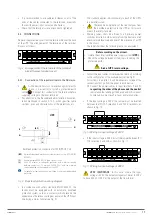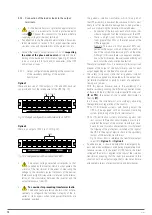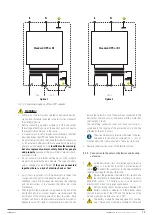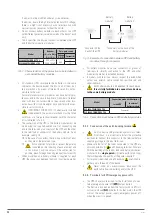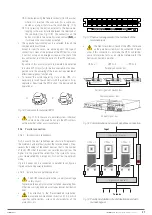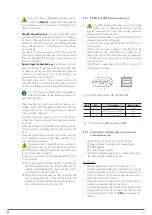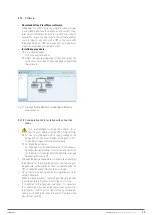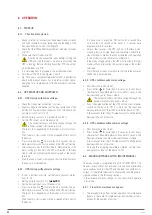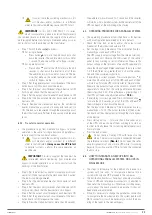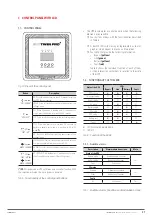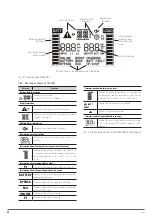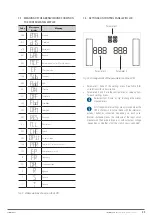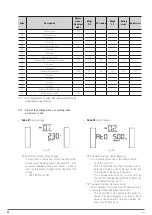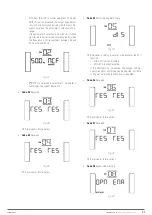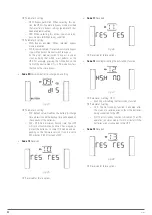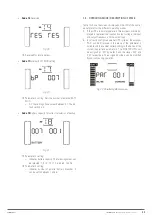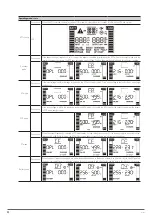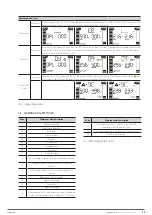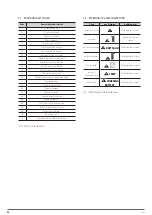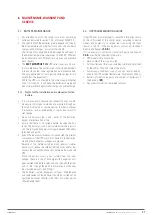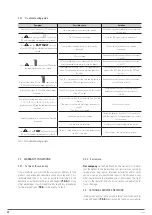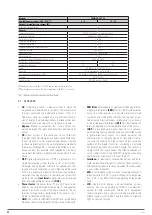
25
If you activate the switching mechanisms (cir-
cuit breakers and/or switches) in a different
order to that indicated,
it
may cause the UPS to fail.
IMPORTANT
. In this SLC TWIN PRO2 T UL series,
which incorporates a galvanic isolation transformer in
the same enclosure as the device, the supply of the load must
be interrupted before transferring to maintenance bypass so as
not to short-circuit the windings of the transformer.
•
Step 1. Switch the device
(s)
to bypass.
For a single device.
–
Press button for more than 0.5 seconds to shut
down the inverter. The audible alarm will sound for
1 second. The device will be set to ‘Bypass mode’.
For a parallel system.
–
Press button on all of the UPSs for more than 0.5
seconds to shut down the inverter in all of them.
The audible alarm will sound for 1 second. The de-
vices that make up the current parallel system will
switch to ‘Bypass mode’.
•
Step 2. Set the general output circuit breaker of the distri-
bution board to OFF to disconnect the loads
•
Step 3. Set the input circuit breaker of each device to OFF.
At this point, check that the devices turn off
•
Step 4. Set the output circuit breaker of each device to OFF
•
Step 5. Set the non-isolated Neutral disconnector of each
device to OFF
•
Step 6. Remove the mechanical lock on the distribution
board’s manual bypass switch or disconnector and set it to
ON. The loads are repowered through the manual bypass of
the distribution board. Perform the necessary maintenance
tasks.
6.3.2. Transfer to normal operation.
•
The procedure to go from maintenance bypass to normal
operation is the same for single devices and parallel sys-
tems, except for the number of actions:
If you activate the switching mechanisms (cir-
cuit breakers and/or switches) in a different
order to that indicated,
it may cause the UPS to fail.
In parallel systems, perform the same operation on
each device.
IMPORTANT
. Similarly, supply of the load must be
interrupted before transferring from maintenance
bypass to normal operation so as not to short-circuit the
windings of the transformer.
•
Step 1. Set the distribution board’s manual bypass discon-
nector to OFF and reassemble the mechanical lock. Caution:
The loads stop being powered
•
Step 2. Set the non-isolated Neutral disconnector of each
device to ON
•
Step 3. Set the input circuit breaker of each device to ON.
At this point, check that the devices turn on in bypass
•
Step 4. Set the output circuit breaker of each device to ON
•
Step 5. Set the general output circuit breaker of the distri-
bution board to ON to repower the loads
•
Step 6. Press the startup button for more than 0.5 seconds,
the audible alarm will sound for 1 second and the inverter
will start up. For a parallel system, do the same for all of the
UPSs and each of them will begin the startup.
6.4. OPERATING PROCEDURE FOR A PARALLEL SYSTEM.
•
The operating procedure established here is for devices
with a configuration determined by factory default.
•
Check that the load or loads and/or the output circuit
breakers of the distribution board are ‘Off’.
•
Set the input circuit breakers of the distribution board or
manual bypass and each UPS to ‘On’.
The UPSs supply output voltage from the internal static by-
pass of each unit. Observe the LCD screen of the control
panel for any warnings or error information. Measure the
output voltage at the terminals of each UPS separately to
check that the voltage difference between them is less than
1 V. If the difference is greater than 1 V, check the connec-
tion and the associated instructions.
•
If everything is correct, proceed. Press startup button for
more than 0.5 seconds on all of the UPSs and each of them
will start up. All of the UPSs will transfer to ‘Normal mode’.
Measure the output voltage at the terminals of each UPS
separately to check that the voltage difference between
them is less than 0.5 V. If the difference is greater than 1 V,
the UPSs will need to be adjusted (contact
T.S.S.
).
•
If everything is correct, proceed. Press shutdown button
for more than 0.5 seconds on all of the UPSs and each of
them will begin to shut down the device.
Set the input circuit breakers of the distribution board or
manual bypass to ‘On’. The output terminals of the distribu-
tion board will be under potential through the static bypass
of the device.
•
Press startup button for more than 0.5 seconds on all
of the UPSs and each one of them will begin to start up
in order to finally leave the system in parallel operation in
‘Normal mode’.
•
Start the load or loads.
•
Do not leave a floating UPS with respect to the
others. There must always be a connection between
the reference terminals
(Non-In)
. Do not open the refer-
ence disconnectors of one or more UPS while it is running
because this will cause the UPS to fail and the connected
loads to stop.
6.5. HOW TO INTEGRATE A NEW UPS INTO AN
OPERATIONAL PARALLEL SYSTEM, OR A UPS IN
SINGLE MODE.
•
The steps to follow are for the addition of a device to a
system with two units. To incorporate a device into a
system with only one UPS, proceed in the same way.
•
The distribution board must have input and output switches
for each UPS and reference disconnectors, in addition to
the one for the manual bypass. Otherwise, it will be neces-
sary to adapt the board or acquire a new one if it has not
been previously anticipated.
•
Since it is necessary to change the parallel bus connection
to incorporate the new device into the system (cable with
DB15 connectors), it will be necessary to switch the pow-
ering of the loads to the manual bypass.
SLC TWIN PRO2 T
UL
UNINTERRUPTIBLE POWER SUPPLIES (UPS)
USER MANUAL







